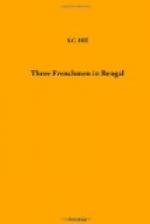“Mr. Law I have put out of the city, and have wrote expressly to my Naib[96] at Patna to turn him and his attendants out of the bounds of his Subaship, and that he shall not suffer them to stay in any place within it."[97]
At the end of April the Nawab wrote to Abdulla Khan, the Afghan general at Delhi, that he had supplied Law with Rs.10,000. Clive was quickly informed of this.
On the morning of the 16th the French marched through Murshidabad with colours flying and drums beating, prepared against any surprise in the narrow streets of the city. Mr. Watts wrote to Clive:—
“They had 100 Europeans, 60 Tellingees,
30 hackerys”
(i.e. bullock-waggons) “and 4 elephants
with them."[98]
Close on their track followed two spies, sent by Mr. Watts to try and seduce the French soldiers and sepoys. Law left a M. Bugros behind in charge of the French Factory.
Shortly after leaving Cossimbazar, Law was reinforced by a party of 45 men, mostly sailors of the Saint Contest, who had managed to escape from the English. On the 2nd of May the French arrived at Bhagulpur, the Nawab writing to them to move on whenever he heard they were halting, and not to go so fast when he heard they were on the march.
“To satisfy him we should have been always in motion and yet not advancing; this did not suit us. It was of the utmost importance to arrive at some place where I could find means for the equipment of my troop. We were destitute of everything.”
These contradictory orders, and even letters of recall, reached Law on his march, but though he sent back M. Sinfray with letters to M. Bugros and Coja Wajid—which the latter afterwards made over to Clive—he continued his march to Patna, where he arrived on the 3rd of June, and was well received by Raja Ramnarain, and where he was within four or five days’ march or sail from Sooty, the mouth of the Murshidabad or Cossimbazar river, and therefore in a position to join the Nawab whenever it might be necessary.
In the mean time fate had avenged Law on one of his lesser enemies. This was that Ranjit Rai, who had insulted him during his interview with the Seths. The latter had pursued their old policy of inciting the English to make extravagant demands which they at the same time urged the Nawab to refuse. To justify one such demand, the English produced a letter in the handwriting of Ranjit Rai, purporting to be written at the dictation of the Seths under instructions from the Nawab. The latter denied the instructions, and the Seths promptly asserted that the whole letter was a forgery of their agent’s.
“The notorious Ranjit Rai was driven in disgrace from the Durbar, banished, and assassinated on the road. It was said he had received 2 lakhs from the English to apply his masters’ seal unknown to them. I can hardly believe this. This agent was attached to the English only because he knew the Seths were devoted to them.”
This incident warned the Seths to be more cautious, but still the plot against the Nawab was well known in the country. Renault, who had been at this time a prisoner in Calcutta, says:—




